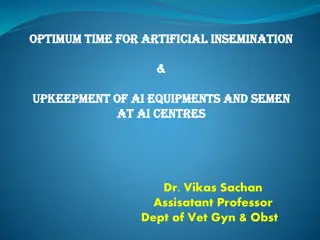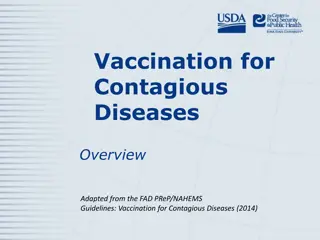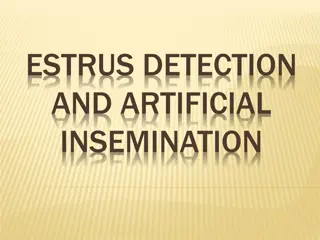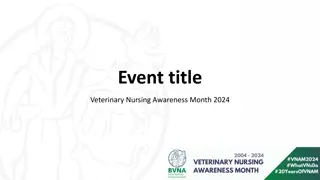Overview of Artificial Insemination in Veterinary Practice
Artificial Insemination, a technique involving the deposition of semen into the female reproductive tract using artificial means, has a rich history of development dating back to ancient times. Starting from the Arab Horse Breeders in 1322 A.D. to modern advancements like cryopreservation and long-distance transport of semen, this method has revolutionized animal breeding practices. Various milestones, such as the first successful AI in cattle by Ivanovich Ivanoff in 1909 and the use of cryoprotective agents like glycerol, have contributed to its success.
Download Presentation

Please find below an Image/Link to download the presentation.
The content on the website is provided AS IS for your information and personal use only. It may not be sold, licensed, or shared on other websites without obtaining consent from the author.If you encounter any issues during the download, it is possible that the publisher has removed the file from their server.
You are allowed to download the files provided on this website for personal or commercial use, subject to the condition that they are used lawfully. All files are the property of their respective owners.
The content on the website is provided AS IS for your information and personal use only. It may not be sold, licensed, or shared on other websites without obtaining consent from the author.
E N D
Presentation Transcript
Introduction of Artificial Insemination Dr. C. S. Azad Assistant Professor cum Jn. Scientist Veterinary Gynaecology and Obstetrics drazadvet@gmail.com
Artificial Insemination The term Artificial Insemination, commonly called AI implies the deposition of Semen into the female reproductive tract by the use of Artificial means (instruments) rather than by natural service involving the male. (Tomar,1970) Artificial Insemination means the deposition of the semen from a male into the female genitalia during oestrus by mechanical means rather than by the direct service of the respective male. In natural mating, the male ejaculates semen directly into the vagina or near the os uteri of the female. With the technique of Artificial Insemination semen is collected into an artificial vagina exteriorly. It is evaluated for its qualities and is extended and preserved with suitable media prior to use. The processed semen is inseminated into the reproductive tract of receptive females. A.I is a technique in which semen are collected from the male, processed, stored and artificially introduced into the estrous female reproductive tract at proper time for the purpose of conception.
HISTORY AND DEVELOPMENT Year Author Development 1322 A.D. Arab Horse Breeders Inseminated Mares with Stallion s semen. 1677 Antoni van Leeuwenhock and Johann Hamm Demonstrated motile cells in semen and referred it as Animalcules. 1780 Lazzaro Spallanzani (Father of Modern A.I) A. I. in amphibians and in a bitch, he also proved that the fertilizing power of semen resided in the spermatozoa carried by spermatic fluid 1786 John Hunter Narrated semen are mawkish and unpleasant Taste - first it is insipid & later pungent and the first discharge is bluish white in color & creamy in consistency. 1799 John Hunter Artificial Insemination in Human beings. 1890 French veterinarian Repiquet A.I. in Horses and advised it as a means of overcoming sterility. 1890 Sand and Stribolt Obtained 4 successful conceptions after Artificial insemination in 8 mares.
Year Author Development 1909 Ivanovich Ivanoff (Russian) First man who successfully did A.I in cattle, sheep and birds 1914 Professor Amantea (Human Physiologist) Designed artificial vagina for dogs 1933 Walton Described the handling of semen 1934 Miller and Evans Ampullary massage technique in bulls. 1935 Gunn Electroejaculator for rams. 1936 Edward Sorensen and Jens Gylling Holm first co-operative artificial breeding association in Denmark 1938 E.J.Perry first co-operative artificial breeding association at New Jersey in U.S.A. 1938 Milovanov Devised artificial vagina for bull, stallion and ram and extenders for diluting the semen. 1938 Laplaud, Thiabault and Cassou Devised electroejaculator for bulls 1949 Polge, Smith and Parkes Cryoprotective effect of glycerol in frozen semen. 1951 Stewart Birth of first calf born from frozen semen 1952 Smith and Polge Glycerol as a cryoprotective agent and freezing of semen at -196 C in liquid nitrogen 1955 Perks Cattle breeding association First time used pellets as packaging materials 1957 American Breeders Service of Madison, Wisconsin Practiced the use of long distance transport of semen in dry ice or in liquid nitrogen.
Indian Scenario 1939 Sampatt kumaran First man who did A.I in cattle at the palace dairy herd of Maharaja of Mysore. Inseminated Hallikar cows with semen collected from Friesian bulls. 1942 P. Bhattacharya established A.I centre at IVRI, Izatnagar 1943 reported the birth of first buffalo calf born through A.I. at Agricultural Institute, Allahabad. 1944 Four regional centers were established throughout India to implement A.I on large scale at Izatnagar, Patna, Bangalore, Calcutta and Montgomery (Pakistan). 1948 Dr. Veeramani Iyer first did A.I in Tamil Nadu at Madras Veterinary College, Chennai 1961 Frozen semen technology was first introduced in India at NDRI, Bangalore.
First five year plan (April, 1951 to March, 1956) a master project the key village scheme was launched. To bring about rapid genetic improvement in the stock, artificial insemination was accepted as a major activity of the scheme for the improvement of cattle and buffaloes in the country Under the scheme 600 key villages and 150 artificial insemination centres were established during the period 1952 to 1956. Second Five-year plan (April, 1956 to March, 1961) the scope of work has been further extended by 1957, 400 artificial insemination centre s were operating. Some private agencies or co-operative organizations dealing with livestock have also adopted artificial insemination for breeding work.
Advantages of A.I. Quick genetic improvement Control of venereal diseases Maximum possible use of best sires Quick progeny testing Economical Correct breeding records Quality of semen Overcome size difference of animal Overcome physical inability of bull Easy transportation Cryopreservation of semen Early detection of undesirable genetic traits in the progeny Good programme for small holding dairy farmers
Disadvantages of A.I. Requires high standards of technical efficiency Proper and timely detection of estrus Proper knowledge of reproduction is required to avoid AI in unwanted conditions. Genetic defects may be transmitted quickly if selection of a bull is not perfect. High risk of inbreeding Costly equipments are required























